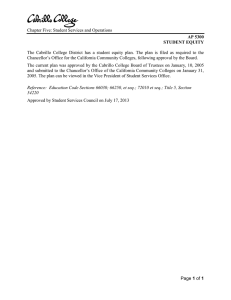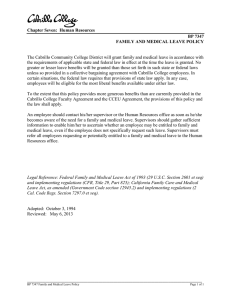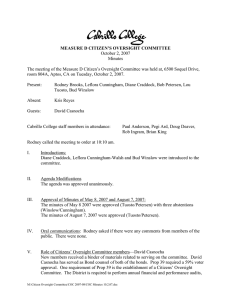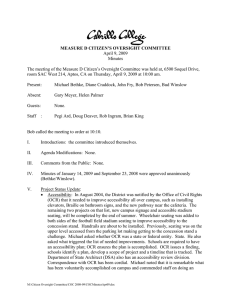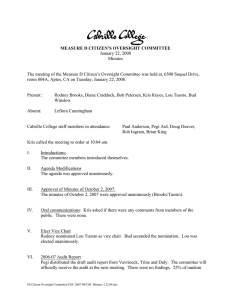MEASURE D CITIZEN’S OVERSIGHT COMMITTEE September 23, 2008 Minutes
advertisement
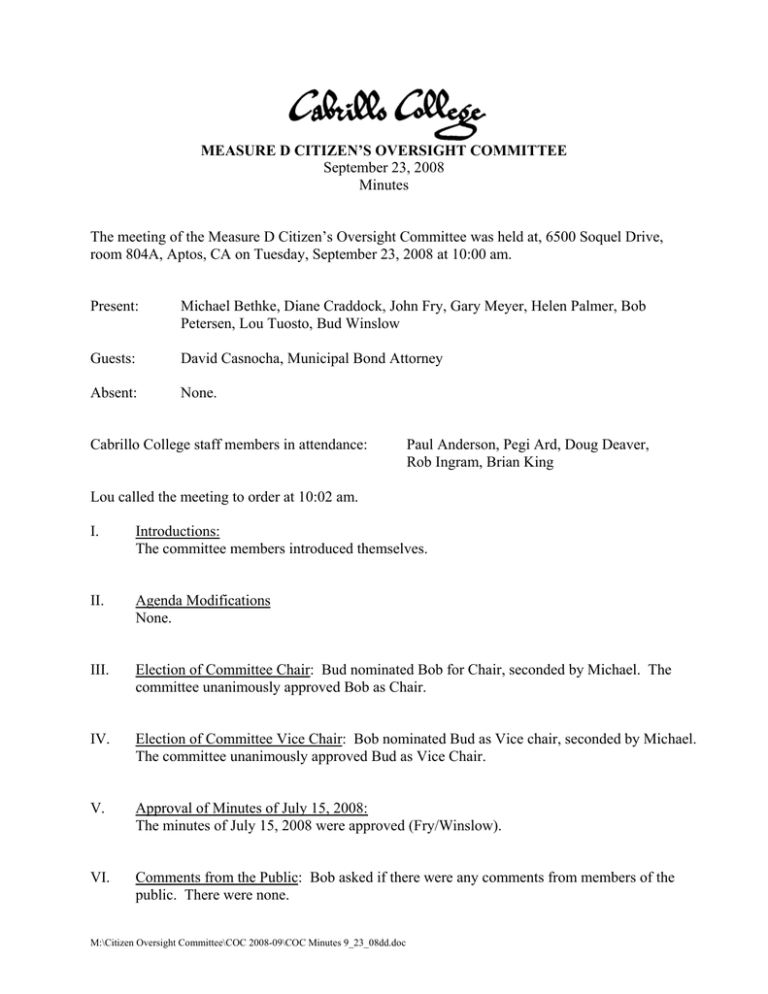
MEASURE D CITIZEN’S OVERSIGHT COMMITTEE September 23, 2008 Minutes The meeting of the Measure D Citizen’s Oversight Committee was held at, 6500 Soquel Drive, room 804A, Aptos, CA on Tuesday, September 23, 2008 at 10:00 am. Present: Michael Bethke, Diane Craddock, John Fry, Gary Meyer, Helen Palmer, Bob Petersen, Lou Tuosto, Bud Winslow Guests: David Casnocha, Municipal Bond Attorney Absent: None. Cabrillo College staff members in attendance: Paul Anderson, Pegi Ard, Doug Deaver, Rob Ingram, Brian King Lou called the meeting to order at 10:02 am. I. Introductions: The committee members introduced themselves. II. Agenda Modifications None. III. Election of Committee Chair: Bud nominated Bob for Chair, seconded by Michael. The committee unanimously approved Bob as Chair. IV. Election of Committee Vice Chair: Bob nominated Bud as Vice chair, seconded by Michael. The committee unanimously approved Bud as Vice Chair. V. Approval of Minutes of July 15, 2008: The minutes of July 15, 2008 were approved (Fry/Winslow). VI. Comments from the Public: Bob asked if there were any comments from members of the public. There were none. M:\Citizen Oversight Committee\COC 2008-09\COC Minutes 9_23_08dd.doc VII. Committee Roles and Responsibilities David complimented Cabrillo for inviting him back to provide new committee members with an overview of the roles and responsibilities each year. Prop 39 requires a 55% voter threshold for approval of bond funds and mandates a Citizens’ Oversight Committee. The District approved a resolution and bylaws for the committee, which set out the role and responsibilities. The three primary legislative responsibilities according to the Education Code are to: 1. Review the expenditures of bond funds and to determine expenditures were for qualified bond projects, such as construction, renovation, furniture or equipment, not teacher or administrator salaries. The full ballot text lists potential qualified bond projects. The Attorney General opined that administrator salaries that are directly connected to bond expenditures may be paid from bond funds. 2. Inform the public of its conclusions with regard to reviewing expenditures. 3. Prepare an annual written report. The committee presents to the Board of Trustees its conclusions whether money has been spent appropriately. In executing these responsibilities, the Ed Code specifies other appropriate activities, such as to receive and review audits, inspect facilities where bond money has been spent, review deferred maintenance plans, review District’s efforts in securing cost saving measures. This committee does not have the authority to intervene and become ad hoc project managers. Cabrillo College has taken appropriate steps to maximize bond funds. In reviewing projects, other funds may be listed from other sources; this committee has no oversight responsibility of those funds. From a due diligence point of view, an appropriate question would be what steps has staff taken to maximize funds. Michael asked about the Grand Jury investigation. It was determined that there was no practice at Cabrillo that is at odds with Education Code or what any reasonable person would say is a good practice. Brian was one of the last to testify before the jury, and by that time it was friendly discussion. The grand jury did not agree with the drafting of the law but with Cabrillo practices. John Fry asked if a report was published. Yes. Information will be sent to the new members. Bud also noted that having served on grand juries, the final result was positive and any lingering questions were answered satisfactorily. Bob commented that the original position of the staff was not adversarial. Also, Bob suggested that the new members meet with Doug to learn about administering contracts and cost savings methods. VIII. Project Status update: Pegi explained that a monthly Facilities Master Plan update is submitted to the Board and there are two semi-annual comprehensive reports. Doug reviewed the August semi-annual report with the committee. We are at the point where projects are finite and most of the money has been allocated. John asked what is DSA? Department of the State Architect. Helen asked if Cabrillo is subject to the local building codes. Doug replied our controlling authority is the DSA, not local agencies, and that our construction standards are dictated by the Field Act. • The Student Activities Center (SAC): This building was occupied in October 2007 and is currently in DSA for final approval. There are plans for a café on first floor. This was a multiple prime contract job. 2 major claims are outstanding on this project. M:\Citizen Oversight Committee\COC 2008-09\COC Minutes 9_23_08dd.doc • Arts Education Classrooms. Three classroom buildings opened for classes this month. The project is a five building complex including a Theater and Music recital hall. Waterproofing should be complete so that work may continue during winter. Anticipated opening the Theater and Music Hall next summer. These two projects were bid at the worst possible time shortly after Katrina in a very challenging environment. John asked if the Board of Trustees have the authority to choose which projects were constructed from the list of projects on the ballot. Yes, the trustees have the authority and responsibility to choose the projects. The second bridge crossing Soquel, for example was very appealing, but where would we be if we spent $3 million for a second bridge but did not have enough funds to construct the Allied Health Buildings. The steps down the middle of the campus from the library to Soquel Drive are used very heavily and provide a safe crossing of Soquel. • Allied Health Classrooms. Paul described that the 510 parking structure is complete. The classroom portion of the project is a month ahead of schedule. The foundation is poured for one building and staff is doing everything possible to support our contractors to stay ahead of schedule. It is anticipated that the buildings will be open for classes in the fall, 2010. • Watsonville Library Acquisition: Demolition of the existing building is scheduled for December with a goal to recycle 95% of the building and reuse many of the materials. The new Industrial Technology Educational Center (ITEC) is striving for platinum level LEED certification, but the Board of Trustees is carefully reviewing the costs and benefits of pursuing the highest level. Programs to be offered at the 9000 sq. ft. facility include photovoltaic construction and energy management. Construction is expected to begin in 2010. Bob asked if Trafton Street will remain open. Cabrillo acquired Trafton Street and will leave it open now but will eventually close it and become a courtyard. Access for parking at the church will be will be provided through the site. Bob asked about the synergy between Cabrillo and Watsonville High School programs, and if ties with Watsonville High can be strengthened. Paul replied that it was decided not to recreate what was offered through the high school. Brian noted that one of the grants we received is a $6,000 grant to open the pipeline from the high school. John asked how the budget is determined. Pegi replied that $7 million was allocated for property acquisition and renovation and was strengthened by a $2.5 million EDA grant. The EDA identified the need in the Watsonville community. It is a significant kudos and big honor to Cabrillo to have received a second EDA grant. The first grant was also for the Watsonville Center. Brian further explained that the Governing Board approves the final budget. When we decided to pursue LEED certification, the Board increased soft costs and staff will go back to the Board to decide the level of LEED certification for the ITEC. John asked when does the program alignment and funding occur, and how does the committee perform its oversight. The role of the committee is to approve appropriate expenditures according to Measure D. The committee receives the same monthly report as does the Board. Twice a year in the semi-annual update funds are M:\Citizen Oversight Committee\COC 2008-09\COC Minutes 9_23_08dd.doc reallocated. John noted that there is no one right way, but the question is what is done. How do Trustees understand estimates and the budget? Is going for gold or platinum level the most efficacious? Brian replied that this was an in depth discussion of Board. The architect was instructed to delineate each level of certification with cost implications and the Board will make the final decision. Each level of certification requires a certain level of points; to get a specific group of points there is a price. John asked how that is done, is there an architectural firm or pricing service? How is pricing and reliability aligned? Brian replied that the architect tends to be project specific and that cost estimates have been a challenging issue. Some parts are counter intuitive: when prices spike, projects might be scaled down, but in California there are great disincentives to redesigning a project after it is approved by the Department of the State Architect (DSA). After downsizing, after losing state funding, it might cost the same for a smaller project than if you had not downsized. The process is not as flexible as is desirable after the footprint is set. It is a challenging cost control environment largely because of the DSA approval process. Michael noted that he has prepared a report to the Trustees for a church in Live Oak which he is working on and feels is germane to Watsonville Library site. Pegi noted that it is important that we try to model as much of the sustainability programs as we can, and that it is hard to factor in the academic drive; discussions have been vigorous. Michael noted that, likewise with the church, the drive is spiritual and discussions vigorous. • Scotts Valley. Classes have been held for the last 3 semesters in a leased building and it has been a very successful project. Rachel Mayo has formulated a committee for north county to look at long-term possibilities for a site and to develop an educational master plan. • Secondary Effects space planning: Doug explained that as we open new buildings, space becomes vacated. An architect consultant is looking globally at space across campus. This is a long-term project. • Stadium seating: OCR cited Cabrillo for inadequate wheelchair seating. There is a bid out for stadium handicap accessibility. • Campus signage: The campus is built on a hill and accessibility is a huge issue. We have 3 new elevators from Soquel to the plaza level of campus for a total of 11. OCR cited Cabrillo to improve directional signage and handicap access. Bud asked for an update on the solar project. Staff is continuing to see if the project is still feasible. We have invested a lot of money into our infrastructure and have attained a very good price for electricity at 10.5 cents per kilowatt hour from PGE. Soquel High pays 15 cents per kwh. The Cabrillo Board of Trustees supports being green but not at a cost of taking money out of classrooms. IX. 2007-08 Annual Report: Pegi thanked the previous committee for compiling the 2007-08 annual report. Kris presented it at the September Board meeting. Next meeting: Wednesday, January 14, 2009 at 10:00 am in room 804A. The meeting was adjourned 11:21 am. M:\Citizen Oversight Committee\COC 2008-09\COC Minutes 9_23_08dd.doc

